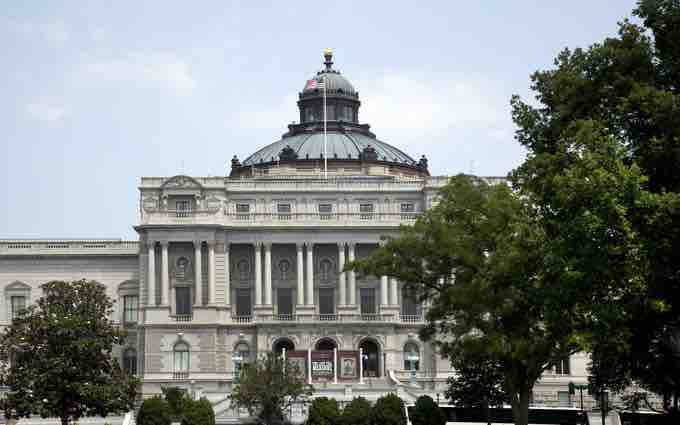Background
The Library of Congress , spurred by the 1897 reorganization, began to grow and develop more rapidly. Herbert Putnam held the office for forty years from 1899 to 1939, entering into the position two years before the Library became the first in the United States to hold one million volumes. Putnam focused his efforts on making the Library more accessible and useful for the public and for other libraries. He instituted the interlibrary loan service, transforming the Library of Congress into what he referred to as a library of last resort. Putnam also expanded Library access to "scientific investigators and duly qualified individuals" and began publishing primary sources for the benefit of scholars.

Library of Congress
The collections of the Library of Congress include more than 32 million cataloged books and other print materials in 470 languages; more than 61 million manuscripts.
Putnam's tenure also saw increasing diversity in the Library's acquisitions. In 1903, he persuaded President Theodore Roosevelt to transfer by executive order the papers of the Founding Fathers from the State Department to the Library of Congress. Putnam expanded foreign acquisitions as well.
In 1914, Putnam established the Legislative Reference Service as a separative administrative unit of the Library. Based in the Progressive era's philosophy of science as a problem-solver, and modeled after successful research branches of state legislatures, the LRS would provide informed answers to Congressional research inquiries on almost any topic. In 1965, Congress passed an act allowing the Library of Congress to establish a trust fund board to accept donations and endowments, giving the Library a role as a patron of the arts.
The Library received the donations and endowments of prominent individuals such as John D. Rockefeller, James B. Wilbur and Archer M. Huntington. Gertrude Clarke Whittall donated five Stradivarius violins to the Library and Elizabeth Sprague Coolidge's donations paid for a concert hall within the Library of Congress building and the establishment of an honorarium for the Music Division. A number of chairs and consultantships were established from the donations, the best known of which is the Poet Laureate Consultant.
Library of Congress Expansion
The Library's expansion eventually filled the Library's Main Building, despite shelving expansions in 1910 and 1927, forcing the Library to expand into a new structure. Congress acquired nearby land in 1928 and approved construction of the Annex Building (later the John Adams Building) in 1930. Although delayed during the Depression years, it was completed in 1938 and opened to the public in 1939.
When Putnam retired in 1939, President Franklin D. Roosevelt appointed Archibald MacLeish as his successor. Occupying the post from 1939 to 1944 during the height of World War II, MacLeish became the most visible Librarian of Congress in the Library's history. MacLeish encouraged librarians to oppose totalitarianism on behalf of democracy; dedicated the South Reading Room of the Adams Building to Thomas Jefferson, commissioning artist Ezra Winter to paint four themed murals for the room; and established a "democracy alcove" in the Main Reading Room of the Jefferson Building for important documents such as the Declaration, Constitution and Federalist Papers.
Even the Library of Congress assisted during the war effort. These efforts ranged from the storage of the Declaration of Independence and the United States Constitution in Fort Knox for safekeeping to researching weather data on the Himalayas for Air Force pilots. MacLeish resigned in 1944 to become Assistant Secretary of State, and President Harry Truman appointed Luther H. Evans as Librarian of Congress. Evans, who served until 1953, expanded the Library's acquisitions, cataloging and bibliographic services as much as the fiscal-minded Congress would allow, but his primary achievement was the creation of Library of Congress Missions around the world. Missions played a variety of roles in the postwar world: the mission in San Francisco assisted participants in the meeting that established the United Nations, the mission in Europe acquired European publications for the Library of Congress and other American libraries, and the mission in Japan aided in the creation of the National Diet Library.
In 2016, Dr. Carla Hayden was appointed as the 14th Librarian of Congress, the first woman, and the first African-American to serve in the position.The library is open to the general public for academic research and tourists. Only those who are issued a Reader Identification Card may enter the reading rooms and access the collection. The Reader Identification Card is available in the Madison building to persons who are at least 16 years of age upon presentation of a government issued picture identification (e.g. driver's license, state ID card or passport). However, only members of Congress, Supreme Court Justices, their staff, Library of Congress staff and certain other government officials may actually remove items from the library buildings. Members of the general public with Reader Identification Cards must use items from the library collection inside the reading rooms only. Since 1902, libraries in the United States have been able to request books and other items through interlibrary loan from the Library of Congress if these items are not readily available elsewhere.